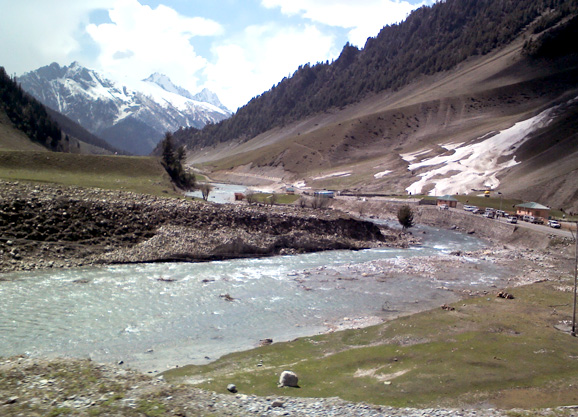
The name Kashmir, in Sanskrit, implies land desiccated from water and is derived from the two words, ‘ka’ (water) and ‘shimeera’ (to desiccate). According to Hindu mythology, Sage Kashyap drained the erstwhile lake to produce the land of Kashmir.
Modern day Jammu and Kashmir (J & K) is the northernmost state of India, lying mostly in the Himalayas. The state shares a border with Himachal Pradesh on the south, Pakistan on the west and China on the north and the east.
As a tourist, you will be spell bound by the beauty of Kashmir the snow clad mountains, the meandering streams, the reflection of water from the magnificent Lakes giving the impression of pearls floating on water, the lush green meadows, the awe inspiring glaciers and above all the invigorating climate. We look forward to see you in the lap of nature
Nicknamed ‘Jewel in the crown of Kashmir’, the Dal Lake is Kashmir’s pride. The lake, which covers an area of 18 sq km and is part of a natural wetland, is fringed by illuminated houseboats and colourful shikaras. The houseboat and shikara communities have survived on the Dal for centuries. Do not miss out on a shikara ride, a boat ride like no other, and do stay in a quaint houseboat with its carved walnut wood furniture. The shoreline of the lake, about 15.5-km long, is encompassed by a boulevard lined with Mughal era gardens, parks, houseboats and hotels. The Char Chinar, four ancient trees on an island in the glittering water, is a mega attraction here. The floating gardens of Dal, known as ‘rad’ in Kashmiri, blossom with lotus flowers in July and August.


Shankaracharya Temple is an ancient temple located on Gopadari Hill dedicated to Lord Shiva. A climb to the hill, located in southeast Srinagar, will take about 40 minutes. Said to be the oldest shrine in the Kashmir valley, this temple stands on a solid rock and consists of an octagonal basement of 13 layers. Be it the chanting of shlokas or the offering of prayers to the presiding deity, Shankaracharya represents the traditional beliefs and customs of Hinduism. The temple offers panoramic view of the Valley. Early April, when the snow lies thick on the mountains, or after rains on a summer day offer the best views from the hill.
The Shalimar Bagh or Farah Baksh, one of the Mughal Gardens of Kashmir, was built by Emperor Jahangir for his wife Nur Jehan, in 1616. Located on the right of Dal Lake, Shalimar Bagh is linked through a channel to the northeast of the lake. Shalimar Bagh has four terraces and a number of fountains, shaded trees and innumerable varieties of flowers. The best views of the garden’s beauty are afforded during autumn and spring, when leaves change colours and flowers blossom, respectively. One can also enjoy a sound-and-light show (son et lumeiere) in the evening, organized daily during the tourist season, May to October.


The temple is dedicated to Goddess Kheer Bhawani (originally just Bhawani) and is constructed over a sacred spring. The colour of the spring’s water changes occasionally. When black or darkish, it’s believed to be an indication of inauspicious times for Kashmir. The famous Kheer Bhawani temple is located in the village of Tulla Mulla, about 22km from Srinagar. The worship of Kheer Bhawani is universal among the Hindus of Kashmir. The term ‘kheer’ refers to the rice pudding that is offered in the spring to appease the Goddess, which became part of the name of the temple. As is the custom with Hindu deities, Goddess Kheer Bawani has many names: Maharagya Devi, Ragnya Devi, Rajni, Ragnya Bhagwati and so on.
Also called the ‘Garden of Pleasure’, Nishat Bagh lies on the left bank of the Dal Lake, with the Zabarwan Mountains as its backdrop. The Mughal garden commands a magnificent view of the lake beneath the snow-capped Pir Panjal mountain range. Nishat Bagh was designed and built in 1633 by Asif Khan, the elder brother of Nur Jehan. The garden is a broad cascade of terraces lined with avenues of chinar and cypress trees, starting from the lakeshore and reaching up to an artificial facade at the hill end. Nishat has twelve 12 terraces representing the twelve signs of the zodiac.


Leading from the Dal Lake is the smaller Nigeen Lake or Nagin Lake. Nagin Lake, which is usually thought of as a separate lake, is divided from Dal Lake only by a causeway. The causeway is mostly suitable for walkers and bicycles only, so it makes for a pleasant way of seeing the lake without having to worry about traffic or Shikaras. The waters are edged by trees of willow and poplar whose reflection is mirrored in the lake. ‘Bathing boats’ here, as well as on the Dal, hire out water-skis and motor launches. The waters of the lake are pleasantly cool from mid-May to mid-September. Shikaras can be hired from any of the steps called ‘ghats’ (jetties) leading to the lake and are a refreshingly novel way of seeing Srinagar by day and at twilight.
Situated near the Chashma Shahi Mughal garden, Pari Mahal has beautiful terraced gardens and the ruins of a five-storied Mughal building that is illuminated in the evening. It offers a fantastic view of the Dal Lake and the city of Srinagar and is the ideal place for some soul searching. Pari Mahal is valued more as a historical monument than a park or a garden. The Mahal was initially a Buddhist Monastery, which was later converted into an observatory and a school of astrology by Dara Shikoh, the eldest son of Emperor Shah Jahan. He dedicated the place to his Sufi teacher, Mulla Shah.


Gulmarg’s legendary beauty, prime location and proximity to Srinagar make it one of the premier hill resorts in the country. While Gulmarg is an all-weather retreat with refreshing summer meadows and pastoral scenes to keep the camera busy, the main reason to come here, at least in winter, is the long-run skiing and snowboarding. Gulmarg is one of the newest and most popular ski destinations. It is also famous for the world’s highest gondola (cable car) ski lift, which will take you from a height of about 8,825 feet to 13,780 feet amid verdant, snowcapped steep hills. Also known as the ‘Meadow of Flowers’, Gulmarg is located 53 km from Srinagar at an altitude of 2,700 meters above sea level. It is surrounded by tall conifers and snowcapped mountains.
The smallest of the Srinagar’s Mughal gardens, the Chashma Shahi or Royal Spring was laid out by Emperor Shah Jahan in 1632. ‘Chashma’ in Urdu means ‘waterfall’. The garden was so named because of a mountain spring/waterfall that feeds it. The famous freshwater spring inside the garden is believed to have medicinal values. As legend goes, when Mumtaz Mahal (Shah Jahan’s wife) fell ill and could not be cured even by the world’s best doctors, somebody suggested she be taken to some health resort. Shah Jahan preferred to stay at Pari Mahal in Kashmir along with his queen. She enjoyed the fresh air and flora and drank the sweet water of Chashma Shahi, resulting in dramatic improvement in her health. Since then, the water here is thought to have medicinal properties. The garden abounds in fruits, flowers and chinar trees.


Sonamarg, also called the ‘Meadow of Gold’, is 87 Km from Srinagar and lies at an altitude of 3,000 metres/9,842 feet above sea level. Soak in the sights and sounds of Kashmiri village life on your drive there. Sonamarg has as its backdrop snowy mountains against a cerulean sky. The Sindh River meanders along here and abounds with trout and mahseer; snow trout can be caught in the main river. One can also hire ponies for a trip to the Thajiwas glacier, a major attraction during the summer months. From Sonamarg, trekking routes lead to the Himalayan lakes of Vishansar (4,084 m), Krishnasar (3,810 m) and Gangabal (3,658 m). Other lakes in the region are Gadsar, stocked with snow trout and Satsar, glacier-fed and surrounded by banks of alpine flowers.
Tulip Garden in Chashma Shahi, Srinagar, is spread over an area of about 30 hectares and is situated at the foothills of Zabarwan Hills with an overview of the Dal Lake. This garden was created in the year 2006-07 with the aim of boosting floriculture and advancing tourism in Kashmir Valley. Lakhs of tulips in about 68 varieties bloom here during November December, making the entire garden look like a bright, colourful carpet of flowers.


The picturesque beauty of Pahalgam or the ‘Valley of Shepherds’, with its streams, valleys and woods will make you feel like you are in paradise. Connect with nature in the lap of the mountains, relax in one of its hotels or trek on one of the many mountains here. One can trek to Lidderwat, Kolohoi Glacier or to Sonamarg from Pahalgam. The resort is surrounded by many places of interest like Baisaran Hajan or Betab Ghat enroute to Chandanwari. Pahalgam, 95 km from Srinagar, has an average elevation of 2,740 metres/8,989 feet. Skiing is a major tourist attraction during the winter months (from December to late February/early March). During spring, the abundance of wild flowers is breathtaking. Pahalgam is also the entry point for the famous Amarnath Cave.
Located about 18 km from Srinagar, Harwan is a huge garden lined with flowerbeds and massive chinar trees. A canal passes through the garden, which is dotted with bright, colourful flowers. The fresh air and big, green carpeted lawns make it an ideal spot for picnics and excursions. The garden serves as a gateway to the famous wildlife sanctuary of Dachigam and Mahadev Mountain. Behind the garden, there is the small but beautiful Harwan lake, which feeds the garden and provides an astounding view of the majestic mountains.



